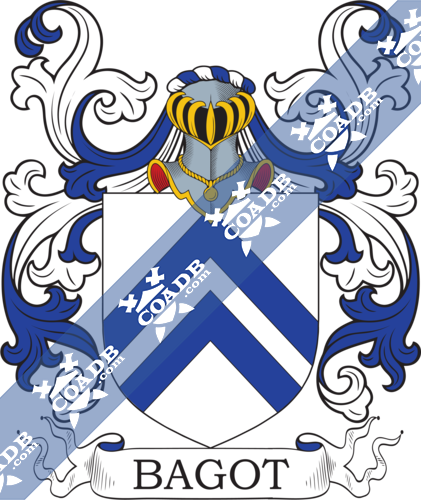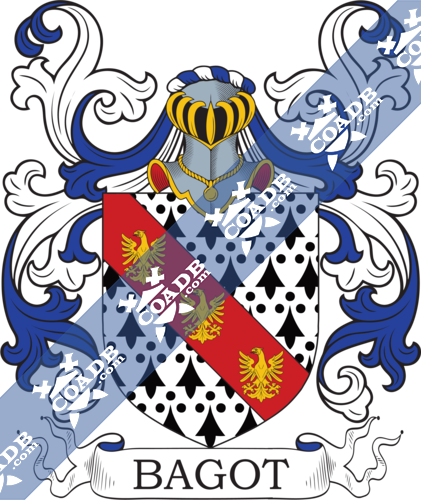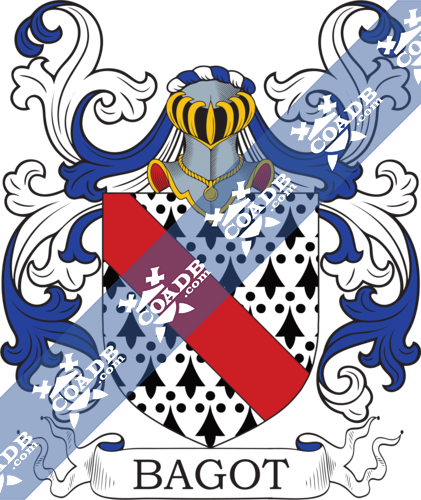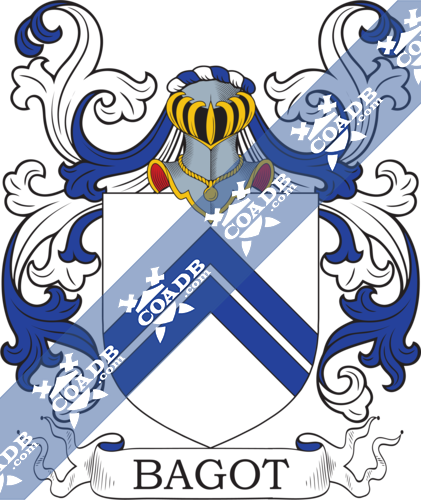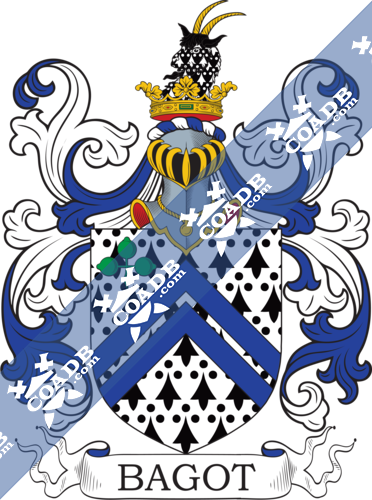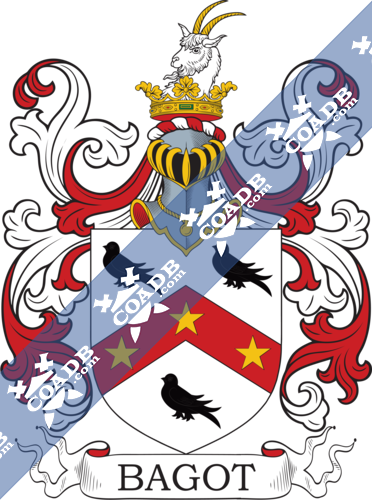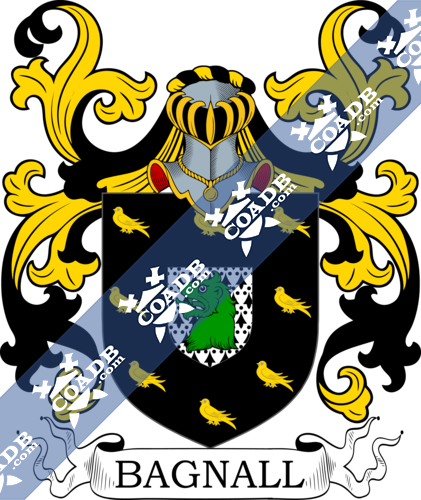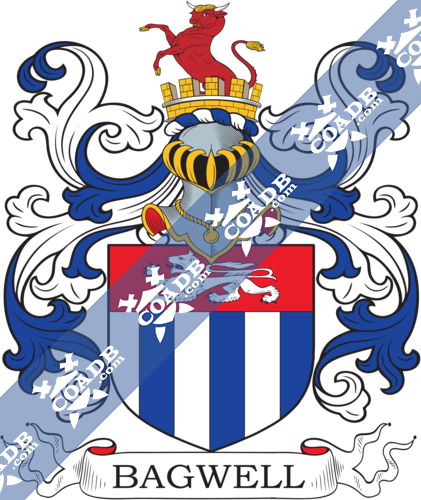Bagot Family Crest, Coat of Arms and Name History
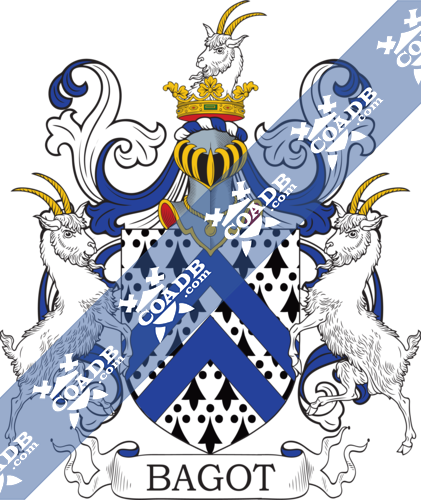
Bagot Coat of Arms Gallery
Don’t know which Coat of Arms is yours?
We can do a genealogical research. Find out the exact history of your family!
Learn MoreSurname Meaning, Origin, and Etymology
Bagot was one of the many surnames that arrived in England after the Norman conquest in 1066. It is originally from the German region, and it is among the most popular last names in the area. It is derived from the personal name Bago, Bac(c)o, or Bahho, which all come from the verb “bag” that means “to fight.”
However, there is another possible origin and meaning of the surname Bagot. It may come from France, meaning a stay, gunstick, walking staff, or drumstick. It may be an adulteration of Bigot.
The first time this surname can be found is in Staffordshire and Warwickshire, England where old records mention a Bago or Bagod de Arras in 1075. He was witness to a charter in Flanders, and after that, he traveled to England when the military conflict was over. Bagod de Arras held the town of Bromley in Staffordshire in 1086.
Spelling Variations
Spelling variations are not a rare phenomenon among Anglo Norman surnames. It is necessary to remark that during this time there was a fusion of two languages in England, the one brought by the Normans, which actually was more than just one, and the already existent language in the region – English. Then they changed for more than a century, which added more variations to this last name, and there was also the medieval scribes, who wrote names according to their pronunciation. As a result, the Bagot surname can be found in old records as Bacot, Baggot, Bagott, Bagod, Baghot, Bachot, and as several other variations.
Popularity & Geographic Distribution
Nowadays, the Bagot surname holds the 88,563rd position in the rank of most common surnames in the world, and it estimated that approximately 4,858 people have it. France is the country where Bagot is most prevalent, and it has the highest density in Guyana. In the United States it occupies the 44,372nd position on the list of most common surnames. All of this data is taken from the census of 2014.
Early Bearers of the Surname
Some of the first and most important bearers of this last name are: Sir Richard Bagot who was a Knight of Bagot’s Bromley, and there was also his son Sir William Bagot (1276-1290), who held the same post. There was also Sir John Bagot who held the post of Knight of Blithfield and Littlehay at Staffordshire, where he also held the rank of Lieutenant of Calais in 1408. He then became Ambassador to the Duke of Burgundy.
History, Genealogy, and Ancestry
Bagod de Arras was the first person of this family to ever appear on a record. Said record was found in Staffordshire and Warwickshire. He arrived in England after attending a charter in Flanders. After that, he held Bromley during 1086. Moreover, Robert Bagod held Bromley during the time that the Domesday Book was written, an important book commissioned by William the Conqueror after the war to keep a record of the ownership of the lands in the region. Then Rodbert Bagod, son of Bagod de Arras witnessed a charter of Geva, daughter of Hugh Lupus, creating Canwell Priory in 1140. Later, there was Hervey Fitz Bagod, son of Rodbert Bagod., who held the same rank as his father and Bromley. Then Hervey had a son, Richard Bagod, who had two sons during the reign of Henry II. The first one was Simon Bagod, the new Lord of Bromley. Through his line, the Bagots remained in Bromley until the marriage between Ralph Bagot and Elizabeth Blithfield, leaving this place to settle in Blithfield. The second son was Hervey Bagod, who had a grandson that was his namesake and later became Baron of Stafford when he married the heiress of the Baron Stafford in 1195. Therefore, his son took the last name and also the title of Baron Stafford. All the barons and earls of Stafford, as well as the Dukes of Buckingham, descended from him. “Bagod” was a previous form of Bagot.
Furthermore, in documents related to Lincolnshire in the Danelaw circa 1170, an Ingeram Bagot appears. Then there was Herificus Bachot circa 1195 in the Warwickshire Curia Rolls. Three years later, in the Staffordshire Feet of Fines, there was a record of a Simon Baghot. The London Church Register had records in which this surname appears, such is the case of John, son of Humphrey Baggott who appears in the records on January 6th, 1627, and a marriage between Thomas Bagot and Elizabeth Baxter in St. Giles Cripplegate on August 1st, 1658.
Centuries later, from this side of the family, there was a Sir John Bagot at Blithfield who held the title of Baronet starting from 1627. Then in 1780, William Bagot was named Baron.
Early American and New World Settlers
As with many other families, the Bagots decided to travel to America, looking for a new life. This migration didn’t occur all at once; they arrived in the new world over several centuries. According to the records, they started to reach the United States during the 18th century, more specifically in 1752, which was the year when Stephen Bagot arrived in New England. In the following century, specifically in 1811, William Bagot made Philadelphia his new home.
The Bagots also reached Australia aboard the ship “Birman” in 1840, when Charles Harvey Bagot settled in the city of Adelaide. New Zealand was another country that received members of this family such as Walter Bagot, who landed in this nation in 1875 on the ship “Alumbaugh” at the age of 40. On the same year and ship, Ellen Bagot also reached New Zealand when she was only 17 years old, and so did the even younger K. Bagot at 14 years old. All of them made Auckland, New Zealand their new home.
Mottoes
Mottoes were used by families as a way of representing and expressing their values, beliefs, and the code that ruled their members’ way of life. They were used as a war cry or a slogan to identify themselves and became part of the families’ coat of arms during the 14th and 15th centuries, but it wasn’t until the 17th century when they were used widely. However, families reserved the right to show it on their coat of arms.
The motto that identified the Bagot family was “Antiquum Obtinens,” which can be translated as “Possessing our ancient honor.”
Grantees
We were unable to locate any documented grantees for the Bagot family.
Notables
As so happens with all other surnames, some bearers of this last name can be found in recent times, and others in the previous century. This surname is not so easy to find nowadays; however, on this occasion, we will mention the most important throughout a wider period of time.
The first one on the list is Walter Bagot (1731-1806), a cleric from England and landowner who was the third son of old Sir Walter Bagot of Blithfield; the second is Richard Bagot (1782-1854), an English bishop who held this position in several religious institutions, and the third is Lewis Bagot (1740-1802), who was also a cleric and the fifth son of Sir Walter Bagot of Blithfield.
Some years later, there was an Army officer and a politician with a Conservative stance from Surrey, England called Josceline Fitzroy Bagot (1854-1913) . From England, there was also a novelist named Ricard Bagot (1860-1921).
In Australia, there was a politician and business owner named John Bagot J.P., along with his son Walter Hervey Bagot (1880-1963) who was an architect and co-founder of Woods and Bagot in 1905. John Tuthill Bagot (1819-1870) was also an Australian and an important politician, and in sports, there was a professional cricketer named John Bagot (1842-1901).
Blazons & Genealogy Notes
1) (Lord Bagot, of Bagot’s Bromley, co. Stafford). Erm. two chev. az. Crest—Out of a ducal coronet or, a goat’s head ar. attired of the first. Supporters—Two goats ar. attired or. Motto—Antiquum obtinens.
2) (Staffordshire). Ar. two chev. az.
3) Or, on a cross gu. five escallops ar.
4) or Bacot – Erm. on a bend gu. three spread eagles or.
5) Erm. a bend gu.
6) (William Bagot, Sheriff of Warwick and Leicester, temp. Henry III., son of Robert Bagot, of Morton Bagot, temp. Henry I.). Ar. two chevronels az.
7) (confirmed to Christopher Neville Bagot, Esq., of Aughrane Castle, co. Galway). Erm. two chevronels az. in the dexter chief point a trefoil slipped vert. Crest—Out of a ducal coronet or, a goat’s head ermines horned of the first. Motto—Antiquum obtinens.
8) (from glass in Worcester Cathedral). Ar. a chev. gu. betw. three martlets sa. N.B.—This coat was for a time borne by Bagot of Bagots Bromley, co. Stafford, but the original bearings were resumed by Richard Bagot, who d. 1596.
9) (Castle Bagot, Dublin). Ar. on a chev. gu. betw. three martlets sa. as many mullets or. Crest—As the last.

